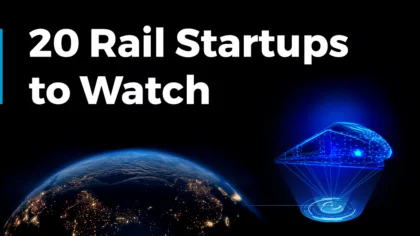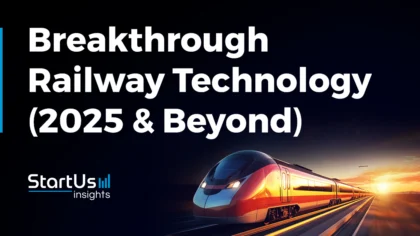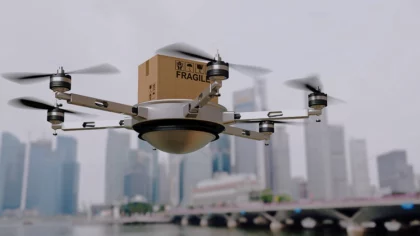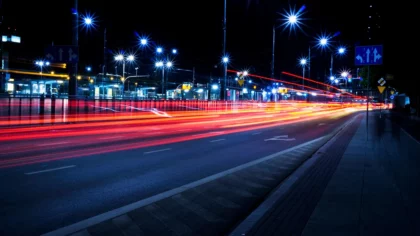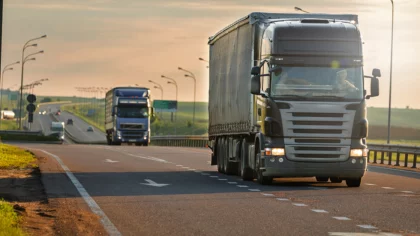Demand for operational efficiency, rising safety concerns, sustainability initiatives, and evolving passenger expectations are driving the developments in the railway industry trends in 2025. Renewable energy integration and hydrogen fuel cells are contributing to making the railway industry a sustainable one.
Technologies like AI, IoT, blockchain, cloud storage, and more further contribute to the development of the industry. Latest innovations like high-speed rail, autonomous trains, and fleet management are additionally improving the passenger experience, operational efficiency, and railway logistics.
What are the Top 10 Rail Industry Trends in 2025?
- High Speed Rail Expansion
- Factory Automation
- Advanced and Recycled Material
- Cybersecurity
- Autonomous Trains
- Renewable Energy Integration
- Digital Twin
- Predictive Maintenance
- Railcar Fleet Management Innovations
- Hydrogen Trains
Methodology: How We Created the Rail Industry Trend Report
For our trend reports, we leverage our proprietary StartUs Insights Discovery Platform, covering 5M+ global startups, 20K technologies & trends plus 150M+ patents, news articles, and market reports.
Creating a report involves approximately 40 hours of analysis. We evaluate our startup data and complement these insights with external research, including industry reports, news articles, and market analyses. This process enables us to identify the most impactful and innovative trends in the railway industry.
For each trend, we select two exemplary startups that meet the following criteria:
- Relevance: Their product, technology, or solution aligns with the trend.
- Founding Year: Established between 2020 and 2025.
- Company Size: A maximum of 200 employees.
- Location: Specific geographic considerations.
This approach ensures our reports provide reliable, actionable insights into the railway innovation ecosystem while highlighting startups driving technological advancements in the industry.
Innovation Map outlines the Top 10 Rail Industry Trends & 20 Promising Startups
For this in-depth research on the Top 10 Rail Industry Trends & Startups, we analyzed a sample of 3130+ global startups & scaleups. The Railway Innovation Map created from this data-driven research helps you improve strategic decision-making by giving you a comprehensive overview of the rail industry trends & startups that impact your company.
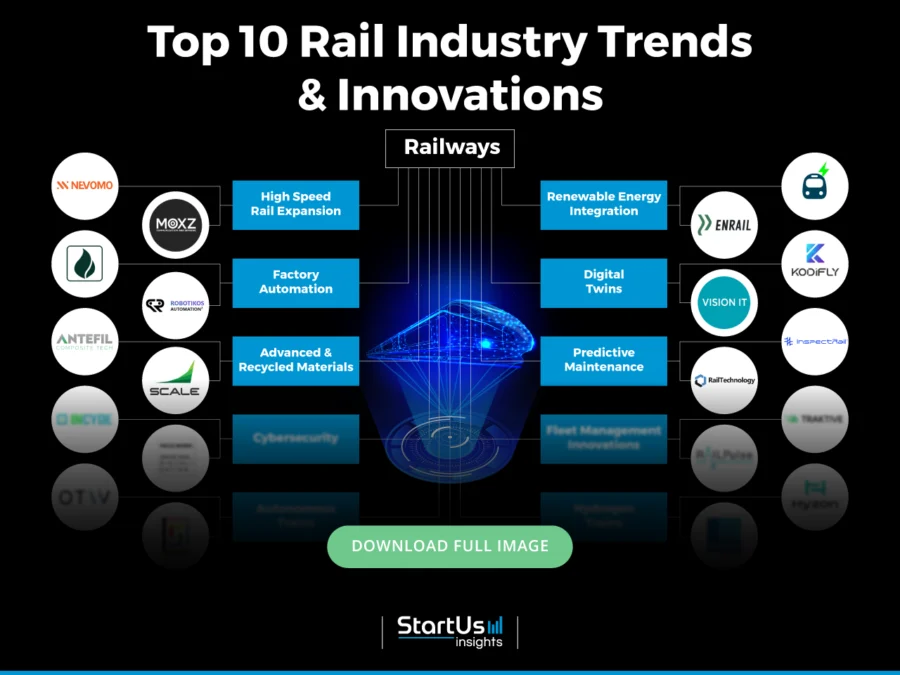
Tree Map reveals the Impact of the Top 10 Railway Industry Trends
Some of the major developments in the railway industry include high-speed rail, autonomous trains, and hydrogen trains. Further, renewable integration in the railway industry reveals its alignment with the current climate crisis mitigation. Additionally, fleet management, factory automation, predictive maintenance, and cybersecurity ensure operational efficiency and improve customer experience.

Global Startup Heat Map covers 3130+ Rail Industry Startups & Scaleups
The Global Startup Heat Map showcases the distribution of 3130+ exemplary startups and scaleups analyzed using the StartUs Insights Discovery Platform. It highlights high startup activity in the US and India, followed by the UK. From these, 20 promising startups are featured below, selected based on factors like founding year, location, and funding.
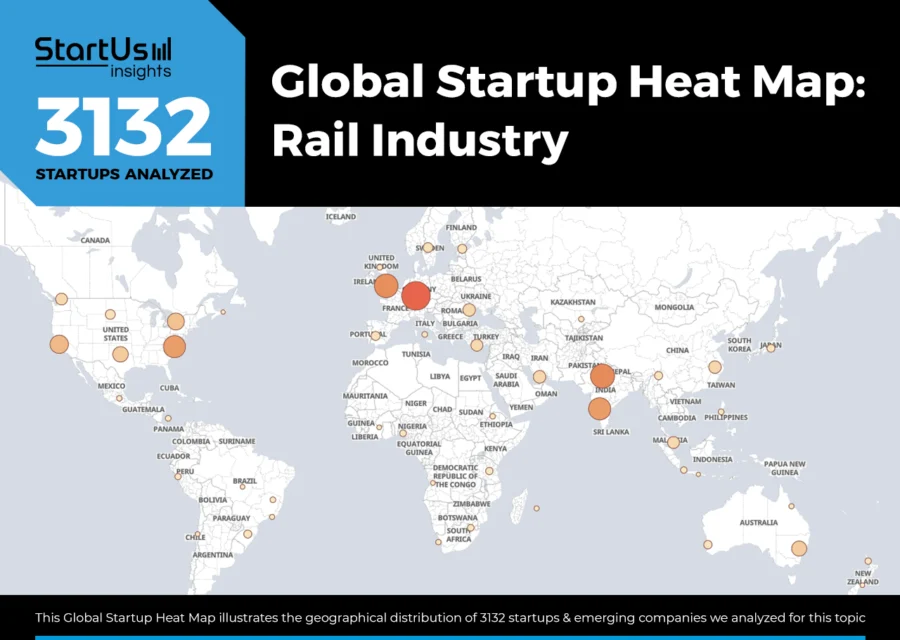
Want to Explore Railway Innovations & Trends?
Top 10 Emerging Rail Industry Trends [2025 and Beyond]
1. High Speed Rail Expansion
High-speed rail expansion led to significant improvements in mobility, travel experience, energy efficiency, reduced congestion, and more. Additionally, it improves business operations in urban and rural centers, leading to more revenue and productivity.
HS2, a high-speed rail project in the UK, is focusing on building a sustainable high-speed rail, which leaves less carbon footprint. Additionally, China is bringing forth new high-speed trains called CR450 trains, capable of speeds over 450 km/h, reducing the distance between Beijing and Shanghai. The list of countries contributing to high-speed rail expansion also includes India, which is building a 7-kilometer-long undersea tunnel as a part of the Mumbai-Ahmedabad high-speed rail corridor.
High-speed train tracks come with less sharp curves and gradients and use continuously welded rails to reduce vibrations and misalignment. These make the tracks long-lasting.
One of the latest technologies accelerating high-speed rail expansion is maglev (magnetic levitation) trains, where powerful magnets lift and propel the train above the tracks. It eliminates friction and allows smooth high speed.
Further, advanced signaling systems like automatic train protection (ATP) and positive train control (PTC) improve the safety of these high-speed trains by preventing collisions. Lastly, artificial intelligence (AI) and the Internet of Things (IoT) enable traffic flow forecasting, predictive maintenance, and real-time scheduling for high-speed rail.
The global high-speed rail market size is predicted to reach USD 99.35 billion by 2034. It is expected to expand at a compound annual growth rate (CAGR) of 6.35% from 2025 to 2034.
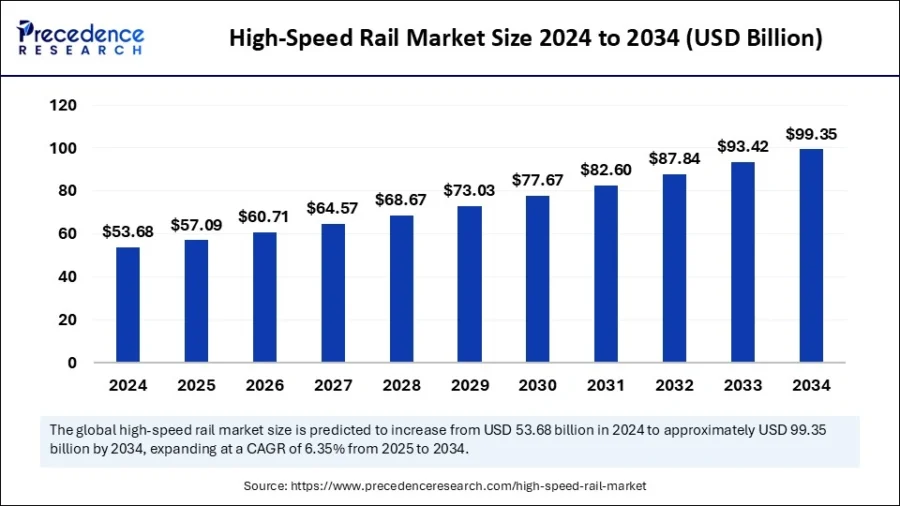
Credit: Precedence Research
Nevomo manufactures Passive Magnetic Levitation Trains
Polish startup Nevomo builds a passive magnetic levitation train, which runs on the existing railway tracks.
It is a hybrid solution that enables the functioning of both magrail systems and conventional trains on the same track. The NEO-4 is a magrail test track that tests linear motor and magnetic levitation trains.
NEO-3 is a prototype on a medium-length track, which the startup uses to test the power electronics software, hardware components, and control algorithm. This prototype allows the operator to control the position of a single vehicle with the accuracy of millimeters.
The startup also builds NEO-2, which is a magrail demonstrator for testing the Nevomo’s own maglev and linear motor, and HPL-01, a hyperloop prototype pod.
MOXZ enhances Wireless Connectivity for High Speed & Automated Trains
German startup MOXZ provides customized handheld wireless devices MOXZ-ISAC radios for wireless digital communication. It is suitable for enabling computer-based train control (CBTC) and automated train operation (ATO) in automated trains in tunnels. The radios also address the challenge of unreliable communication within tunnels for high-speed trains.
The startup uses patented wireless transceiver technology MOXZ for integrated communication and sensing (ISAC), real-time tracking of other devices, and detection of line-of-sight conditions.
The radios are battery-powered and come in a waterproof casing. It allows ultra-reliable low-latency communication (URLLC) applications and distance tracking between two mobile devices.
By connecting the MOXZ radios to any wired infrastructure, it is possible to retrieve the real-time 3D positioning of all connected devices. It also enables integrated communications that require radar applications including wireless networks, industrial automation, and more.
The technology works smoothly in rough environments like underground or heavy metallic areas where cellular or GNSS services are unavailable.
2. Factory Automation
The railway industry uses IoT, AI, digital twins, 5G connectivity, and more to enable factory automation. Devices with IoT enable real-time monitoring of the manufacturing process, data collecting, and analysis to optimize asset management.
Further, AI and machine learning (ML) enable predictive analytics to optimize production schedules, autonomous quality control, and real-time fault prediction in rail track conditions.
Robots are also used for autonomous inspection of tracks for cracks and misalignment, welding of tracks, and handling heavy objects around the manufacturing unit. For instance, Robel Rail Automation uses robots from FANUC to repair and maintain railway lines.
Additionally, digital twins and immersive technologies like AR and VR provide testing simulations of the railcars and tracks before they are used in reality.
Factory automation leads to increased efficiency, improved quality, cost savings, worker safety, and data-driven decision-making in the railway manufacturing process.
Reflecting these trends, the global industrial control and factory automation market is set to reach USD 399.12 million in 2029, growing at a CAGR of 9.3% from 2024 to 2029.
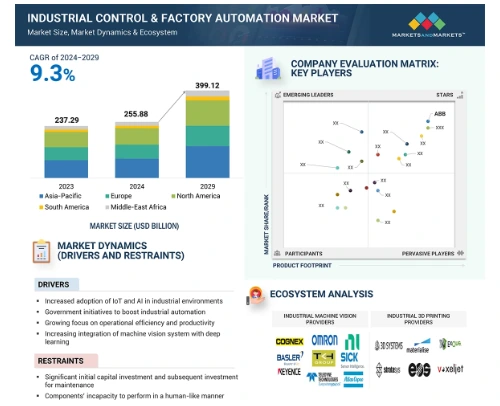
Credit: Markets and Markets Research
Green Factory AI provides Real-Time Railway Manufacturing Optimization
Finnish startup Green Factory AI offers an AI-powered SaaS platform for continuous monitoring and real-time optimization of manufacturing units.
The railway industry uses this platform for monitoring automatic train supervision (ATS), enabling predictive maintenance, production data collection and analysis, and more.

It also performs an optimization loop with the AI agents to ensure continuous learning from operational data.
The collaborative intelligence further allows operators to talk to the AI agents in real-time, facilitating instant changes and remediation. The platform also runs detailed simulations of the factory and its lifecycle using generative twin shoes.
Railway operators also test different scenarios like recessions, disasters, and balancing profitability, and environmental goals using the simulations.
Robotikos designs a Railway Automation Analysis Platform
German startup Robotikos provides an automation planning tool, Automation2 for monitoring and managing investments in automation software. It plays the role of a digital assistant for factory automation of the railway industry. The tool assists in industrial planning, speeding tasks, maintaining consistency, and structuring decision-making for factory automation.
The tool uses a built-in financial model for automation analysis and error-free assessment. It also combines all inputs from relevant departments and ensures the investment decision is backed by cost analysis and ROI calculations.
3. Advanced and Recycled Material
Manufacturers use recycled plastic for track infrastructure and rolling stock components. It is also suitable for composite railway sleepers, drainage pipes, service conduits, fencing, and level crossing panels.
Plastics make the structures lightweight, resistant to rot and reduce plastic waste. Recycled glass, concrete aggregate, ballast, and metal are also fit for track infrastructure components.
Advanced materials like carbon fiber composite are ideal for bogie frames, interior components, and overhead line structures. Similarly, glass fiber-reinforced polymers (GFRP) are fit for bridge decks and platforms.
Composite materials combine lightness with structural strength, ideal for reducing wagon weight and improving energy efficiency. Carbon fiber composites provide significant weight reduction in the structures and high strength-to-weight ratio, and GFRP provides durability, corrosion resistance, and cost-effectiveness.
Materials like high-density polymeric foams and sound-absorbing composites improve user comfort by reducing noise and heat transfer. The railway industry also uses other advanced materials like graphene-reinforced materials, high-performance steel, nanomaterials, and advanced polymers.
The rail composite market is set to reach USD 2.4 billion by 2028, growing at a rate of 7.2% CAGR from 2023 to 2028.
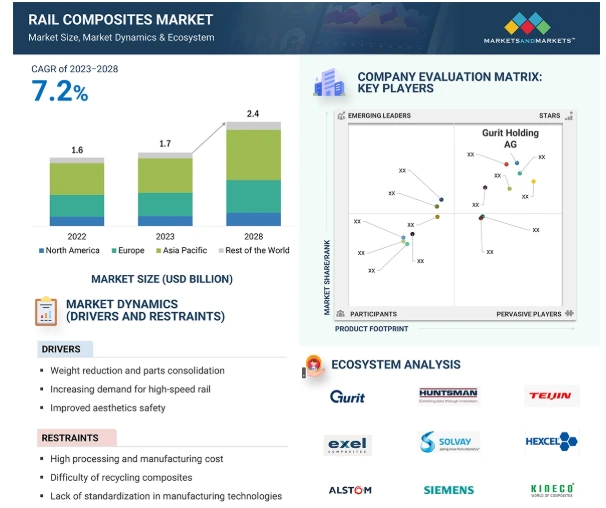
Credit: Markets and Markets Research
Antefil Composite Tech makes Microengineered Hybrid Fibres for Lightweight Railway Structures
Swiss startup Antefil Composite Tech produces energy-efficient lightweight structures from fiber-reinforced plastics (FRP). The combination of stiff reinforcement fibers and lightweight polymers makes the FRP ideal for reducing the energy demand of load-carrying structures.
Railcar manufacturers use fiber-reinforced materials to reduce the vehicle’s energy usage. It also makes the structure lightweight, affordable, and strong. The startup also offers high-quality thermoplastic composites, which ensure reduced gas permeability for hydrogen tanks in railcars.
The single-glass hybrid fibers offered by the startup already contain thermoplastic on the microscale. It employs a thermoplastic in-line process with a fiber spinning process, which is ideal for high-volume production. The hybrid fibers are pliable preforms that transform into lightweight structures using heat and minimal pressure.
The production process requires less time as the fibers don’t require curing or impregnation. The aerospace-grade laminate quality of the fiber with low void content and complete fiber wet-out additionally ensure mechanical performance.
SCALE Advanced Biocomposites offers Advanced Composites for Sustainable Train Manufacturing
French startup SCALE Advanced Biocomposites provides biocomposite materials that produce less CO2 than conventional advanced composites. The biocomposite materials include rovings and filaments for reinforced fabrics.
Using these biocomposites, the railway industry manufactures lightweight vehicles which in turn ensure less carbon footprint and more fuel efficiency.
The Bio|Power is a roving that improves the performance-to-cost for natural-and-carbon fiber composite applications. The Bio|Control filaments dampen the performance-sapping vibrations. It also improves the flexural strength of natural and synthetic fiber composites, which optimizes the strength-to-weight features of the composite material.
When the Bio|Power filament is integrated into the Bio|Control roving or flax roving, it creates a fully natural fabric. The filament is also used with carbon, glass, and basalt rovings to improve their vibrational damping.
4. Cybersecurity
Due to the 220% increasing railway-associated cyberattacks over the past five years, cybersecurity is becoming a critical trend in the railway industry.
AI plays an important role in railway cybersecurity. AI provides end-to-end support starting from anomaly detection and predictive threat intelligence to automated incident response.
AI-based anomaly detection monitors the network traffic and detects unusual activities. Further, predictive threat intelligence analyzes historical cyber threats and mitigates future attacks. Automated incident response isolates affected railway components and prevents malware from spreading. This reduces downtime and widespread disruption.
Additionally, AI-optimized encryption dynamically adjusts encryption keys to reduce the risk of stolen credentials in railway communication networks. Data packet inspection enables railway network traffic scanning to detect hidden cyber threats and prevent unauthorized control from reaching controls. Security information and event management systems (SIEM) also monitor and respond to unusual activities to prevent potential cyberattacks.
Nokia offers quantum-safe IP and optical networking to protect data from intrusion and theft through quantum-safe encryption and key management for the railway industry. Additionally, Cylus from Israel and RailTel collaborated to build CylusOne, a rail-specific cybersecurity solution.
The railway industry also employs network segmenting and access controlling methods like prude model implementation and firewalls and intrusion detection systems (IDS). They create security zones and conduits between system components and control information flow between them.
The railway cybersecurity market is projected to reach USD 10.6 billion by 2027, at a CAGR of 9.4% from 2025 to 2027.
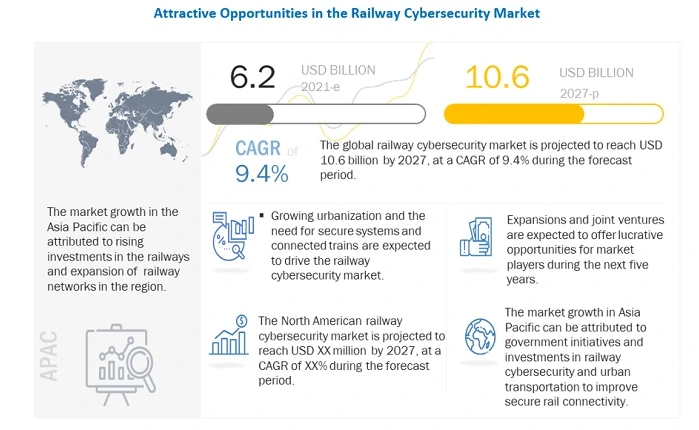
Credit: Markets and Markets Research
INCYDE designs Cyber Security for Operational Technologies (OT) in Railway
German startup INCYDE provides cybersecurity services for the railway industry. The services include designing, implementing, verifying, and training.
It is ideal for automatic train operations (ATO), digital interlocking (DSTW), and the European Train Control System (ETCS). The services support standardized interfaces like EULYNX and OCORA, security standards like IEC 62443, and IEC 63452, and security legislation like NIS 2 and CRA.

The startup specializes in information technology and operational technology cybersecurity. It addresses the increasing cyber-attacks caused by the digitization and networking of railway systems. The services also mitigate the risk created by modern technologies like automated train control and real-time data processing.
INCYDE develops a risk-based security strategy using systems engineering, testing, and validation/verification assessment. The strategy covers conception, risk analysis, and specifications.
PECS-WORK enhances Rail Operations Cybersecurity
German startup PECS-WORK supports rail operators in digitizing their operations. The process starts by assessing whether the railway sector’s technologies fulfill all necessary safety and security requirements.

PECS-WORK creates a safety case, which contains risk analysis according to the specifications and structures of EN 50129. It also contains proof and analysis of reliability, maintainability, and lifecycle costs.
The cyber security case includes security risk analysis and security case verification. PECS-WORK also creates technical fault trees and failure mode effects analysis of the digital rail operations.
5. Autonomous Trains
Autonomous trains address labor shortages, improve operational responsiveness, and optimize passenger experience. It also improves service quality and reduces operational costs by running autonomously.
Such systems leverage communication-based train control (CBTC), automatic train protection (ATP), and automatic train operations (ATO). While CBTC facilitates communication between trains and track equipment, ATP ensures safe spacing between trains, and ATO handles non-safety aspects.
Autonomous trains also use sensors for navigating around obstacles, the environment, and platforms as well as AI for calculating optimal speed. The trains further use geolocation technology for forecasting potential hazards.
Additionally, train-to-train (T2T) and train-to-infrastructure (T2I) communication allows trains to communicate with each other as well as signaling and control systems. Connectivity technologies, like 5G and ultra-wideband (UWB), further enable interaction between trains and control centers to ensure precise coordination and minimize disruptions.
The Autonomous Regional Train Evolution (ARTE) is an upcoming project supporting automated regional trains. It is a part of the German rail network and will implement automated train operations (ATO) and European Train Control Systems (ETCS).
Reflecting these activities, the global autonomous train market size is expected to grow at a CAGR of 5.9% from 2024 to 2030.

Credit: Grand View Research
OTIV provides Autonomous Trains Solutions
Belgian startup OTIV facilitates remote and autonomous railway operations with OTIV.FOUR, a self-driving technology. It increases safety efficiency and enables 24×7 operation. OTIV also provides a self-driving simulator that allows testing the OTIV.FOUR software before deploying it.
Moreover, the OTIV.TWO is an advanced driver assistance system (ADAS), which uses a combination of LiDAR, object recognition, sensors, and cameras to provide forward intelligent collision warning. The system is capable of different levels of audiovisual warnings and automatic braking.
Sutra-Teleport designs a Semi-Autonomous Personal Railpod System
German startup Sutra-Teleport offers a high-density system of semi-autonomous personal railpods. They reduce stopping distances, eliminate moving switch track infrastructure, and allow automatic switching of tracks using onboard switching mechanisms.
Moreover, the personal railpods do not require any battery, take the fastest route, and have a sensor and computer-run management. These are available to passengers on demand and are also suitable for transporting groceries, parcels, and other goods.

6. Renewable Energy Integration
Solar panels on train rooftops and railway stations generate electricity for services like lighting, air conditioning, and station operations. Utility-scale solar farms and wind turbines along the railway tracks also generate electricity to power trains and feed electricity into the grid.
The global solar-powered trains market size is expected to be worth USD 4.0 Billion by 2033, growing at a CAGR of 6.2% during the forecast period from 2024 to 2033.
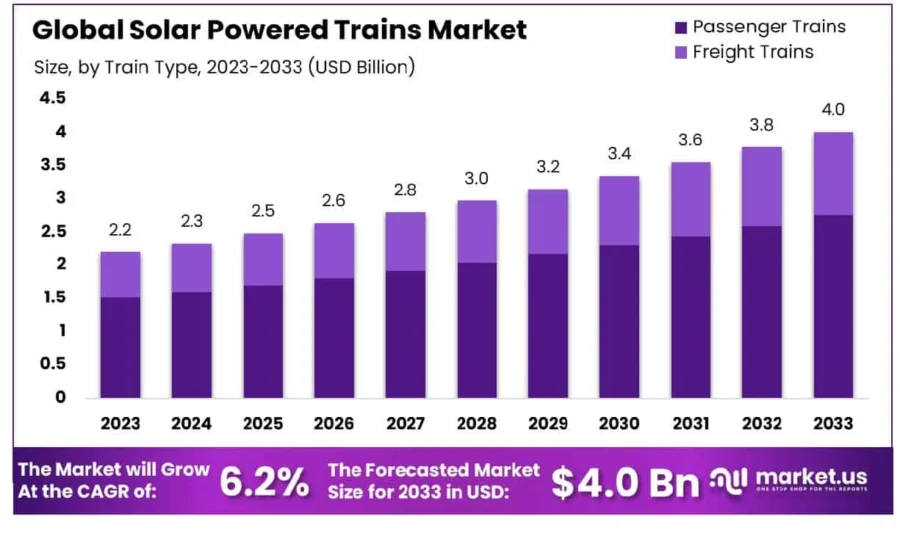
Credit: Market.Us
Additionally, Indian Railways is collaborating with the Nuclear Power Corporation of India to allocate nuclear energy for the railway industry.
Renewable diesel, hydrogen fuel cells, and biofuels further serve as alternatives to diesel and other fossil fuels as the rail industry transitions to clean energy. By 2025-26, direct carbon emissions from the Indian railway industry are expected to reduce to 1.37 million tonnes per year using nuclear, solar, and hydropower energy.
Photovoltaic rail beds utilize available land space along the tracks to generate electricity using sunlight and without disrupting agricultural land. Researchers are also developing energy recovery systems that recover braking energy from trains for reuse within the rail network.
The railway industry also utilizes intelligent multi-agent systems to manage microgrids and integrate various renewable energy with energy storage systems.
To reduce the power losses from renewable energy sources, startups also develop superconducting solutions. The solutions increase the efficiency of electricity use and reduce carbon emissions.
Voltify offers Freight Rail Decarbonization-as-a-Service
US-based startup Voltify provides rail decarbonization-as-a-service using VoltCars.
VoltCars connect to the locomotives and charge dynamically using renewable energy while the locomotive is on route or in the yard. This zero-emission solution provides an off-grid electrical network for freight rail operations.

Voltify further uses an AI algorithm to forecast data and analyze real-time information to maintain energy efficiency without compromising capacity. This way, Voltify improves reliability, reduces maintenance costs, and lowers energy consumption in freight rail.
ENRAIL develops Agri-Photovoltaic (PV) Railway Power Plant
Austrian startup ENRAIL builds an agri-photovoltaic railway powerplant. The agri-photovoltaic system generates energy that is fed into the nearby railway line. It generates 13 MW of power and 19 GWh of energy, which is sufficient for multiple rail journeys. The power plant also ensures no impact on biodiversity.
7. Digital Twin
Digital twins allow rail companies to improve maintenance planning, efficiency, real-time monitoring, cost reduction, safety, and asset utilization. Such solutions leverage IoT-sourced data about various train components and use AI to analyze the data.
Further, 3D/4D modeling and reality modeling create detailed visualization of railway assets for design optimization and predictive maintenance. The modeling technologies use LiDAR and photogrammetry to perform visual inspection, railway mapping, track safety metrics, and gain information about asset conditions. The hybrid application of LiDAR and photogrammetry improves inspection efficiency and mitigates safety concerns with detailed spatial data and visual documentation.
Geographic information systems (GIS) integrate and analyze spatial data of railway networks. These tools identify potential hazards in the surroundings, ensure the stability of railway structures, optimize maintenance, and save the cost of repairing unpredicted damages.
Moreover, railways using digital twin technology have reported a reduction in maintenance costs by up to 30% and a decrease in unplanned downtime by up to 75%.
The Crossrail project in London uses a digital twin that allows workers to use an augmented reality (AR) view of the electricity, water, and communications systems beneath station walls or floors.
The railway digital twin market is set to grow at a CAGR of 29.36% from 2024 to 2030.
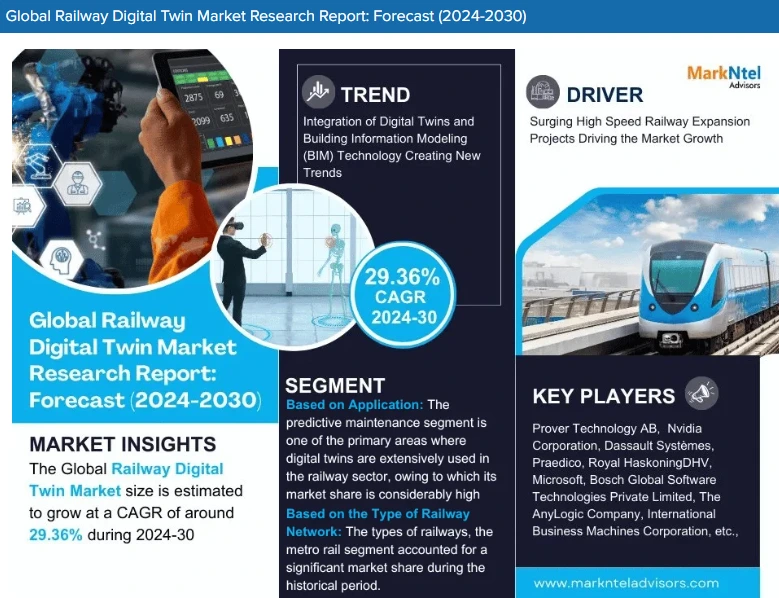
Credit: MarkNtel Advisors
Kodifly improves Railway Infrastructure Management
Hong Kong-based startup Kodifly optimizes railway infrastructure management with digital twins. The startup collects information about the infrastructure using its products SpatialSense Scanner, Spatial Sense Edge Device SE-64, and Spatial Sense Cloud.
The SpatialSense Scanner creates a colorized map of the surrounding area using machine vision, cameras, LiDAR sensors, and an inertial measurement unit (IMU). Further, the Spatial Sense Edge Device SE-64 scans the surroundings, collects data, and provides actionable insights using sensors. It also comes with 5G connectivity and an advanced processing mechanism.
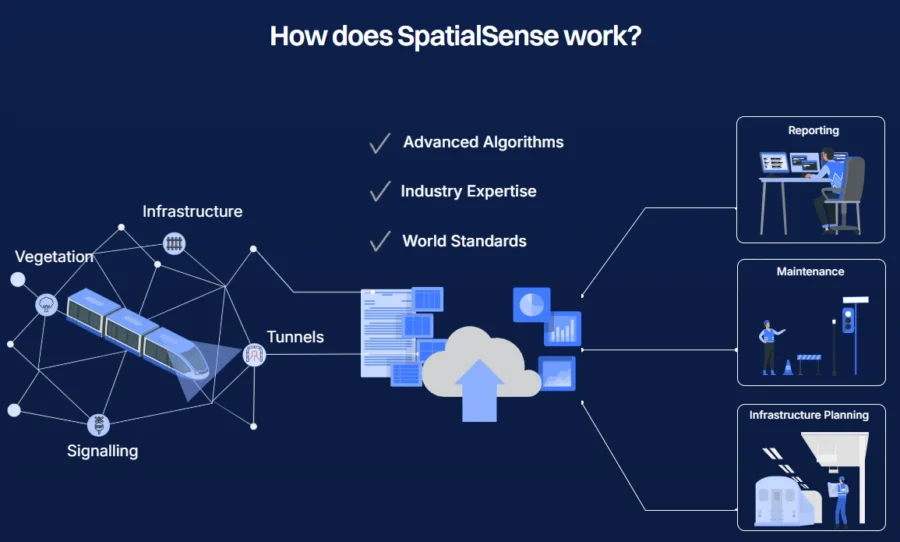
This information powers the startup’s proprietary solutions SpatialTwin: TreeGuard, SpatialTwin: TrackVision, and SpatialTwin: BallastVue. The solutions respectively assist in railway vegetation management, safer railway operations, and 3D visualization of tracks for stability.
The products further enable intelligent ADAS solutions, blind spot elimination, rail corridor mapping, and physical infrastructure analytics systems. Kodifly also provides SpatialTwin Rail, which is an all-in-one platform for railway data storage, visualization, and management.
Vision IT offers Train Operation Virtualization
Ukrainian startup Vision IT digitizes rail vehicle maintenance, inventory, and engineering management functions using a digital twin. It enables live train monitoring as well as operation and maintenance (O&M) management using sensors.
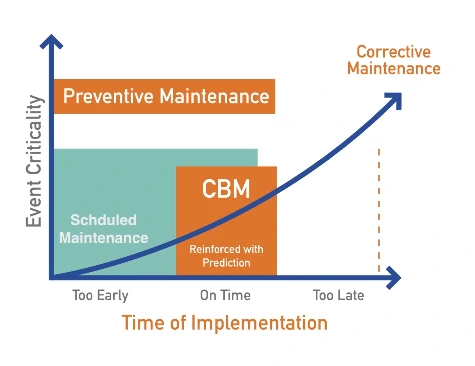
Moreover, the sensors collect data used to virtualize and monitor train operations. It also notifies about failures and incidents.
8. Predictive Maintenance
Predictive maintenance decreases the risk of accidents and derailments, minimizes downtimes and disruptions, and optimizes energy consumption.
IoT-based sensors, across the railway systems, gather information about track conditions, train component health, and wheel and track wear patterns. ML analyzes data collected from the sensors to detect patterns and anomalies and predict potential failures.
AI-powered predictive analytics also analyze data to forecast equipment failure and optimize maintenance schedules. Advanced monitoring technologies like machine vision, ground penetrating radar, fiber optic sensing, and integrated track monitoring systems streamline inspection processes and reduce manual effort and intervention.
Using AI algorithms, the railway industry generates weather-induced maintenance alerts. These algorithms integrate weather forecasts with maintenance systems, which predict potential weather-related wear on tracks and infrastructure.
The railway infrastructure maintenance services market is expected to reach USD 141.39 billion in 2029, growing at a CAGR of 4.6%.
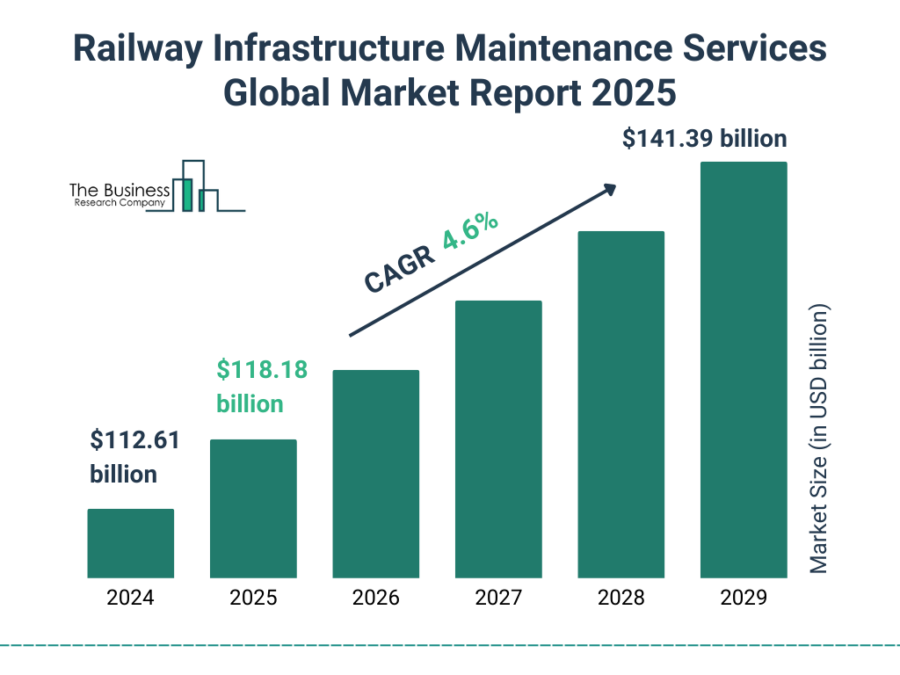
Credit: The Business Research Company
InspectRail digitizes Rail Infrastructure Inspection and Maintenance
Spanish startup InspectRail builds a preventive technology for railway infrastructure inspections and maintenance. It employs a software platform and an autonomous inspection vehicle.
The autonomous vehicle performs infrastructure assessment by measuring the dynamic pantograph-catenary interaction and contact wire geometry. It also monitors the status of wireless communications in railway operations.
The vehicle additionally evaluates the status of beacons and signals, analyzes the environmental condition, and detects rail surface defects and rail wear. The platform provides a visualization of this information, which optimizes operation, maintenance, and management.
RailTechnology manufactures Railway Inspection and Maintenance Equipment
German startup RailTechnology builds Rail Technology RT-I. It is a compact, self-propelled rail-bound vehicle that conducts surveys, inspections, and measurements on mainline and urban railways. It is capable of inspecting track geometry, rail profile, rail corrugation, georadar, and more.
It features an on-board hybrid power technology for emission-free running. This makes it ideal for densely populated areas and tunnel/underground environments. It uses electric traction for functioning and features a lightweight design.
9. Railcar Fleet Management Innovations
Fleet management improves asset and resource utilization and safety while reducing downtime.
Telematics tracking and IoT devices are the critical technologies required for efficient rail fleet management. They enable efficient data collection and transmission, situation monitoring, asset utilization, and GPS tracking.
Further, AI and ML algorithms recognize patterns in weather, demand, and traffic to suggest optimized fleet routes. Further, remote monitoring systems and satellite images provide insights into environmental and urban conditions, which further optimizes fleet management.
The global railway fleet management market size is expected to increase by USD 4.53 billion between 2023 and 2028 at a CAGR of 14.19%.
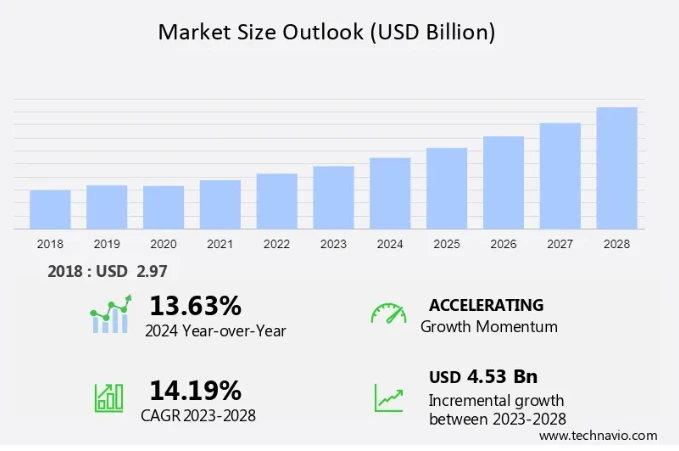
Credit: Infiniti Research
Traktive offers AI-powered Rail Fleet Management
US-based startup Traktive develops a plug-and-play AI platform to simplify rail operations and shipping. The platform cuts costs by providing AI-powered decisions to maximize fleet utilization and reduce demurrage.
The platform further simplifies rail logistics by providing insights into fleet usage and performance, which optimizes asset value, reduces downtime, and identifies potential efficiency improvements. It also offers centralized data visualization and ensures user-friendly navigation for faster adoption.
The AI-based insights and predictive analytics further optimize operations and manage risks. Rail operators use the centralized platform to address disjointed rail data, manual processes, costly delays, and lack of data visibility.
RailPulse develops a Railcar Tracking Platform
US-based startup RailPulse builds a railcar tracking platform RailPulse that provides real-time data about railway tracks using GPS and telemetry sensors. The sensor-agnostic platform transmits the data collected from the telemetry devices to the cloud for analysis and delivery.
The vendor-neutral platform also contains features for alerts, fleet management, and geofences. The data generated by the platform is downloadable into any existing system using an API connection. Further, shippers, lessors, and railroad operators use the platform to gain information about railcar location and its condition and optimize the fleet performance.
10. Hydrogen Trains
Trains using hydrogen as fuel produce only water vapor and heat as byproducts, significantly reducing the carbon footprint of rail transport. Hydrogen fuel cells also convert a higher amount of fuel energy into usable electricity compared to conventional diesel engines.
Proton exchange membrane (PEM) fuel cells and anion exchange membrane (AEM) fuel cells are common fuel cells used in hydrogen trains. These trains feature higher ranges and are refueled within minutes. For example, the Alstom Coradia iLint train traveled 1175 km without refueling its hydrogen tank.
Further, hydrogen trains use high-pressure hydrogen tanks mounted on the train roof for auxiliary systems like heat management and oxygen extraction. The former utilizes the heat generated by fuel cells for air conditioning and the latter extracts oxygen from ambient air for fuel cell reaction.
According to Insight Partners, the hydrogen fuel cell train market is set to reach USD 3.45 billion by 2030, growing at a CAGR of 11.5%.
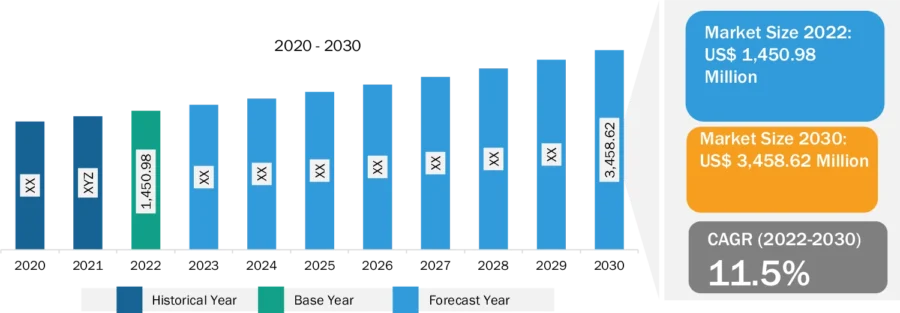
Credit: GlobeNewswire
Hyzon provides High-Performance Hydrogen Fuel Cells
US-based startup Hyzon builds PEM hydrogen fuel cells for heavy industries like railways. The high-performance hydrogen fuel cells convert hydrogen and oxygen from the air into zero-emission electricity.
In addition to a PEM membrane, Hyzon utilizes a hybrid bi-polar plate to distribute hydrogen and air as well as transfer electric current from one cell to another. The balance of plate components further saves space, weight, cost, and complexity.
Moreover, the fuel cells are compact and light, which lowers fuel cell manufacturing costs and increases fuel efficiency in railcars.
Coolergy develops Cryogenic Plants and Equipments
Spanish startup Coolergy provides liquid hydrogen tank containers. These hydrogen solutions enable a major increase in the train’s operating range without refueling.
The liquid hydrogen tank containers come with a non-drainage storage period. It features a vacuum and multi-layer insulation along with a nitrogen screen for maximizing the non-drainage period. The fixation of inner vessels within the outer vessel further reduces the heat losses.
Discover all Rail Industry Trends, Technologies & Startups
The railway industry is set to witness more research and development, which will make it more optimized for both passengers and logistics. Technologies like AI, IoT, and digital twins will make rail more safe, easier to maintain, and more cost-effective.
Additionally, upcoming innovations in connectivity will improve operational efficiency and scale the implementation of autonomous trains. Emerging manufacturing processes, including 3D printing, will also make product development and manufacturing more time and cost-efficient.
The Rail Industry Trends & Startups outlined in this report only scratch the surface of trends that we identified during our data-driven innovation & startup scouting process. Identifying new opportunities & emerging technologies to implement into your business goes a long way in gaining a competitive advantage.



